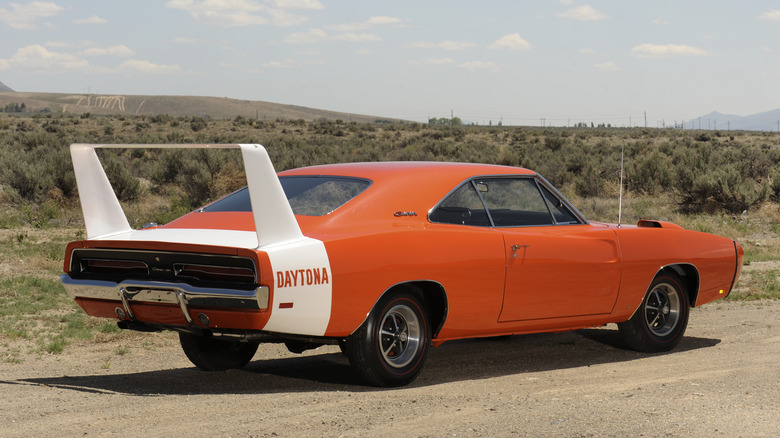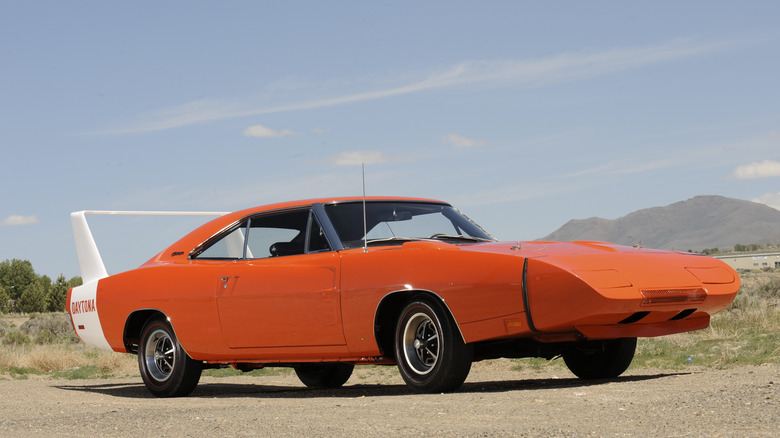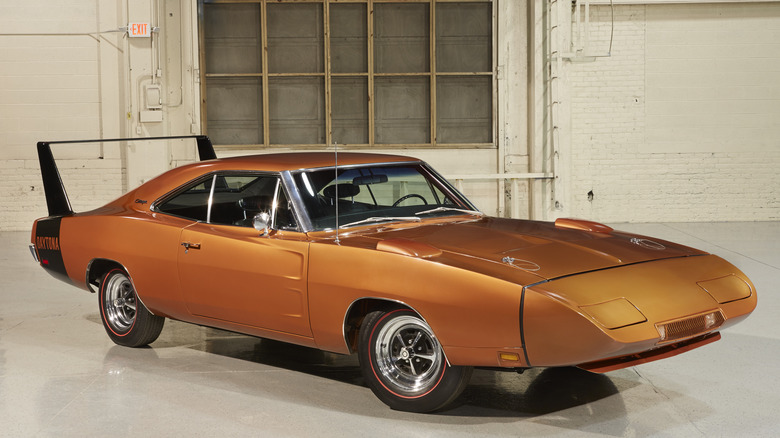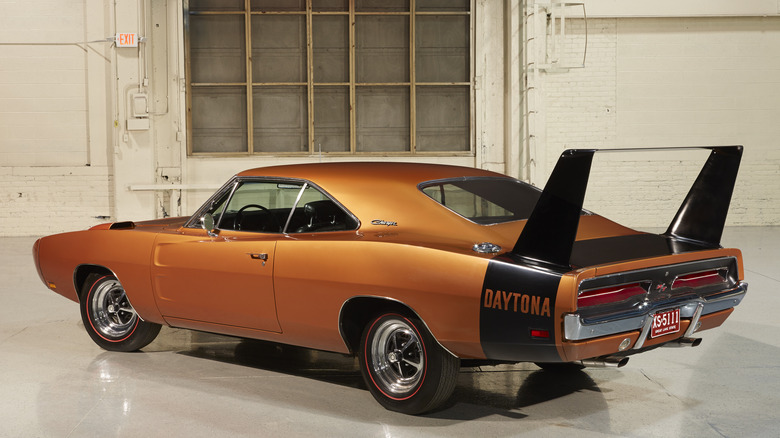The Reason NASCAR Banned The Legendary Dodge Charger Daytona
In 2022, the Dodge Charger Daytona is a future EV. In 1969, it was something else entirely. That Charger Daytona was a supercar decades before that word came into the modern lexicon. It was made to do one thing: win at NASCAR races.
NASCAR of the 1960s is wildly different than the mega spectacle it is today. For one, stock cars were ones anyone could go out and buy. They were modified for safety and tuned for racing but were more or less the same cars you could find in a dealership. NASCAR regulations at the time stipulated that any car used in a race had to be mass produced and available for sale.
Dodge had the idea to take a 1969 Dodge Charger, an already extremely capable muscle car, and squeeze every possible ounce of performance out of it. It was equipped with the legendary 426 cubic inch "Hemi" V8 or 440 cubic inch V8 and given aerodynamic upgrades that would make a Cessna jealous (via MotorBiscuit).
A winged terror
From Talladega to Daytona, the Charger Daytona was a monster for anyone racing against it. It was the first stock car to hit 200mph on a track.
Over the 1969 and 1970 seasons, the aerodynamic Charger won six races. It's cousin from Plymouth, the Superbird, won eight races (via Motortrend). Ford attempted to follow up with its own cars, the Ford Torino Talladega and the less-subtly named Mercury Cyclone Spoiler II. These vehicles, with their wild aerodynamics were dubbed the "Aero Cars." And NASCAR didn't like them one bit.
NASCAR banned the ludicrous wings and nose cones after just a year. The Daytona was just too good at racing.
Overall, Dodge made just 503 Charger Daytonas before setting its sights on more pedestrian cars. Nowadays, Charger Daytonas are incredibly rare, and seeing one in person is special. Surviving examples sell for absurd amounts. Even dilapidated barn finds demand huge prices at auction.
Over 50 years later, the Charger Daytona is remembered as a prime example of function over form. It looked wild and raced like it too.
An aerodynamic marvel
Part of the secret to the Daytona's success was its huge rear spoiler as it looks like designers took styling cues from aircraft rather than other racecars. The wing was for more than just showing off as it provided an immense amount of downforce to keep the car planted on the track when racing. At almost 200 miles per hour, any amount of downforce the car can provide makes a huge difference in not only handling characteristics but also prevents the car from literally lifting off the ground. It also gave the car a better drag coefficient than supercars like the McLaren F1 (via Silodrome).
It's no secret that the Dodge Charger the Daytona was based on was an incredibly popular car. Several decades later, the car is still iconic. But despite the fame, it wasn't a competitor when it came to racing. According to the NASCAR Hall of Fame, the 1968 Dodge Charger's front grille and rear window made the car's aerodynamic properties more akin to that of a brick than a serious racecar. The Dodge Charger Daytona all but eliminated those difficulties with a then bizarre-looking nose cone and its now legendary rear spoiler. Those upgrades did the trick as four Charger Daytonas topped the leaderboards in the model's debut race in Alabama in 1969.
The end of the aero cars
Entries from Chrysler were so dominant in racing at the time that by the time the 1970 Daytona 500 rolled around 23 of the 40 cars on the track were Dodge Charger Daytonas, or its similar cousin, the Plymouth Superbird (via NASCAR Hall of Fame). William France Sr. also known as "Big Bill" and the founder of NASCAR was the one to put a lid on not only the aerodynamic wonder cars from Dodge and Plymouth but every automaker in 1971.
Along with rules banning the Dodge Charger Daytona's unique brand of aerodynamic wackiness, NASCAR banned the use of large displacement engines. New rules kept the size limited to just 305 cubic inches, significantly smaller than the Daytona's 426-cubic-inch and 440 cubic-inch engine options. With the NASCAR rule changes and Dodge's winged wonder leaving for good, it put an end to the era where someone could buy almost the exact car they saw racing on Sunday.
The Charger Daytona accomplished exactly what it was set out to and stands as one of the few cars in history that were so crazy and unconventional that it took pieces of motorsport legislation to stop it.



